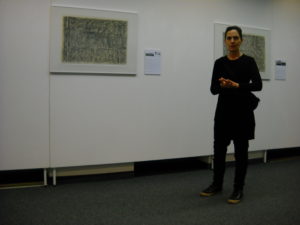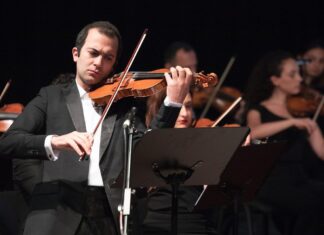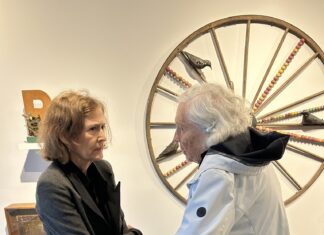Special to the Mirror-Spectator
BOCHUM, Germany — Thousands of Armenian descendants of Genocide survivors, especially from the United States, have had the opportunity to travel though eastern Anatolia, in the search for the villages and towns their ancestors lost, many of them guided on pilgrimages organized by the indefatigable Armen Aroyan. In Germany over the past year large numbers of people have been able to make a similar trip, albeit vicariously, through the unique medium of art. Starting in 2015 in commemoration of the centenary of the genocide, Lisa Stybor, a German artist and art professor, launched a series of exhibits of works she composed during a six-week trek through those same lands. After having presented the show in Bochum in the context of Armenian cultural events, on February 5 she concluded an exhibit in Chemnitz, a city in the former Communist East Germany.
Titled “AGHET, The Trail of Tears,” the exhibit presents 20 works, abstract in form but very concrete in depicting the drama of the deportations and the genocide. As the artist explained during the reception marking the end of the show at the Chemnitz Artists Union gallery, her own voyage to Armenia as a subject was a long one that had its conceptual beginnings in 1986.
At that time, while studying as a Fulbright scholar in Oklahoma, she became acquainted with the tragic history of the native Americans, whose expulsion, she learned, was known as the “trail of tears.” This led her to pose the question of her own cultural identity and its history. As a student she had traversed the history of European art, from the Renaissance to Bauhaus, and had from an early age taken up pencil and brush. “Drawing and painting for me were like eating and drinking, something I did every day as part of my normal activities,“ she explained. In search of her cultural identity, she travelled backward in time, visiting cities first in Germany and Italy, then in Sicily and North Africa, with their rich Greek heritage; from there she went to Greece itself, and further back in time, to Egypt. In the course of this cultural voyage into the past, she was exploring concepts of space, agricultural space in landscapes, and also architectonic space. In the early 1990s, as a professor at Dessau University, she expanded her search for spatial concepts through architecture, but also through literature and music. Especially significant was her encounter with Johann Sebastian Bach and his Art of the Fugue, which opened up an entirely new understanding of spatial and temporal relations.
“I then looked at myself, through time,” she explained, “reviewing my development from child, to girl, to woman,” and did drawings on this theme, as well as landscapes, especially from Italy. While exploring this organic development process, she was also posing questions of possible simultaneity of temporal phases.









